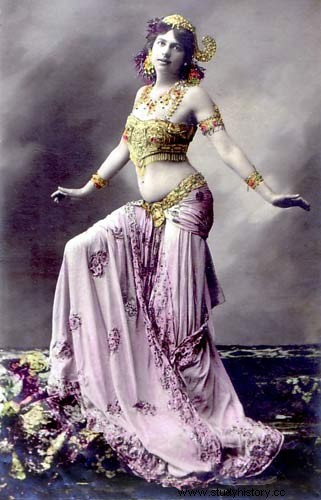Dancer and courtesan, Margaretha Geertruida “Grietje” Zelle (1876 – 1917) , better known as Mata Hari, was executed by France for espionage during the First World War.
Wedding to Rudolf MacLeod
 Daughter of Antje van der Meulen and Adam Zelle, a wealthy merchant, Margaretha was born on August 7, 1876 in Leeuwarden, the Netherlands. In 1889, his father went bankrupt. Her parents separated in 1890 and her mother died in 1891. Margaretha studied to become a teacher but, following a scandal concerning an affair with the director, she was fired.
Daughter of Antje van der Meulen and Adam Zelle, a wealthy merchant, Margaretha was born on August 7, 1876 in Leeuwarden, the Netherlands. In 1889, his father went bankrupt. Her parents separated in 1890 and her mother died in 1891. Margaretha studied to become a teacher but, following a scandal concerning an affair with the director, she was fired.
On July 11, 1895, following a marriage announcement, she married Rudolf MacLeod, a Dutch naval officer 19 years older than her. The couple moved to Java, Dutch East Indies, where MacLeod was appointed garrison commander. There, Margaretha immerses herself in the local culture, learning oriental dances and some notions of the language. She had two children with her husband but their nurse, Rudolf's lover, poisoned her son in 1899. Rudolf became alcoholic and violent and, in 1902, Margaretha returned to the Netherlands and divorced. She gets custody of her daughter but Rudolf kidnaps her.
Beginning of a career as a spy
In 1903, at the age of 26, she moved to Paris and was supported by men. In 1905, she was hired as a rider in Ernest Molier's "Nouveau cirque" where she put on a belly dancer number. In 1905, she triumphed in an erotic show as an exotic dancer at the Guimet Museum, under the name of Mata Hari (“sun” in Malay). Following this success, Margaretha went on tour throughout Europe and performed from capital to capital. She invents a character, claiming to be born in Java and initiated into the secrets of the cult of Shiva by his priests. She multiplies the liaisons, including one, which will be reproached to her later, with the German lieutenant Alfred Kiepert.
This affair also damages his career. Margaretha gets into debt, performs in popular shows and prostitutes herself in brothels. In 1915, in the midst of the First World War, she received a visit from the German consul Carl H. Cramer who offered to repay her debts in exchange for strategic information for Germany by returning to Paris. Thus begins her career as a spy.
Double spy
 At the end of 1916, while taking steps to visit a wounded man in the infirmary, Margaretha met Captain Georges Ladoux, head of the French counterintelligence services. He in turn offers him to put his knowledge and connections at the service of France, by spying on the German High Command in Belgium. She accepts for a fee. On the way, she is interrogated by MI5 (British secret services) and introduces herself as an agent of the French secret services, which they do not confirm. She eventually travels to Spain, where she seeks to seduce the German military attache, Major Kalle, by posing as the German spy codenamed H-21.
At the end of 1916, while taking steps to visit a wounded man in the infirmary, Margaretha met Captain Georges Ladoux, head of the French counterintelligence services. He in turn offers him to put his knowledge and connections at the service of France, by spying on the German High Command in Belgium. She accepts for a fee. On the way, she is interrogated by MI5 (British secret services) and introduces herself as an agent of the French secret services, which they do not confirm. She eventually travels to Spain, where she seeks to seduce the German military attache, Major Kalle, by posing as the German spy codenamed H-21.
In January 1917, Kalle sends a message to Berlin describing the actions of Agent H-21, with an insecure code and enough information to recognize Mata Hari in it; perhaps it was a way of unmasking Margaretha's double game, working for both sides at once. The French secret services intercept the message and identify agent H-21 as Mata Hari. Shortly after returning to France to join a lover, her room is raided and she is arrested.
What a strange French custom of executing people at dawn!
Subjected to interrogation in prison, Margaretha provides little information. His trial is expedited. In a France martyred by war, in the context of the mutinies that are beginning, she is an ideal culprit.
Sentenced to death for intelligence with the enemy in time of war, which is high treason, her pardon was rejected by President Poincaré and she was shot on October 15, 1917 in Vincennes. She would have refused the blindfold that was to be covered over her eyes, threw a kiss at the soldiers of the firing squad and exclaimed, just before she died:"What a strange custom of the French to execute people at dawn!" »
A true legend, Mata Hari continues to inspire films, books and video games.
